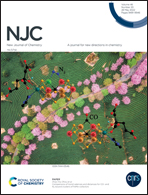Highly improved acetone oxidation performance over mesostructured CuxCe1−xO2 hollow nanospheres†
Abstract
Hierarchical bimetal oxide solid solutions in hollow-interior nanospheres with mesoporous shells have versatile applications in environmental protection, but their synthesis still encounters great challenges. In this work, mesostructured CuxCe1−xO2 hollow nanospheres with porous shells and controllable Cu/Ce molar ratios were newly fabricated by a facile solvothermal strategy for the first time to catalyze acetone oxidation. The experimental results revealed that Cu0.015Ce0.985O2 showed the optimal catalytic acetone oxidation performance, accomplishing 100% acetone conversion and 100% CO2 selectivity at 210 °C under reaction conditions of 1000 ppm acetone, 20% O2/N2 and WHSV = 90 000 mL gcat−1 h−1. The optimal catalytic acetone oxidation performance of Cu0.015Ce0.985O2 can be mainly credited to the integrated factors of the unique architecture of hollow-interior nanospheres with mesoporous shells, increased numbers of defective sites and active oxygen species, and enhanced redox capacities. Impressively, Cu0.015Ce0.985O2 also demonstrated strong water tolerance and good long-term stability owing to its highly stable crystal phase and robust morphological structure, showing great potential in cleaning volatile organic compounds for environmental protection.



 Please wait while we load your content...
Please wait while we load your content...